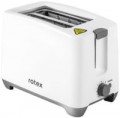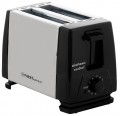Roasting degree
The number of roasting levels provided in the device.
This parameter is relevant primarily for models with step adjustment (see "Control"). Each degree of roasting corresponds to a certain fixed power setting in them. Accordingly, the more such steps, the more options the user has, the more accurately he can set the preparing mode. At the same time, we note that even for an advanced model, 8 – 9 steps are considered quite sufficient, a larger number is extremely rare. And for simple household use, more than 5 – 6 steps are rarely required — unless you plan to cook according to specific recipes.
Note that the number of degrees of roasting can also be indicated for equipment with smooth adjustment. However, these are not fixed settings, but only auxiliary divisions on the adjustment scale; they are applied in order to make it easier to navigate for the user. So you can not pay much attention to this moment when choosing a device with smooth adjustment.
Features
—
Auto-centering. Function found in toasters (see "Type"). Thanks to auto-centering, each slice of bread is placed in the centre of the compartment during cooking, at the same distance from the heating elements, and toasted on both sides equally.
—
Heating. Operating mode of the toaster (see "Type"), in which the product is not fried, but only slightly warmed up. This function can be useful, for example, to reheat previously cooked toast.
—
Defrosting. Toasters often include a specialized function, found in their features (see Type), for toasting frozen bread. Frozen bread cannot be directly fried, as it requires defrosting first. The toaster's defrost mode provides a convenient way to defrost frozen bread quickly and efficiently.
—
High lift. Possibility of lifting cooked toast above the standard height. This feature is useful when toasting small slices of bread that would otherwise be difficult to remove from a hot toaster.
—
One-sided frying. Possibility to toast on one side only. This function can be useful, for example, when making toast from a piece of bread — on the one hand, it no longer needs to be fried.
— Readiness indicator. An external indicator, typically in the form of a light, is used to signal the completion of cooking in certain toasters
...(see Type). It's worth noting that in traditional toasters, this function is relatively uncommon. Instead, the completion of toasting is indicated by the toast popping up from the compartments accompanied by a noticeable click and sometimes an additional sound.
— Overheat protection. Safety system that automatically turns off the device when the heating element or body reaches a critical temperature. This allows user to avoid unpleasant consequences, ranging from a breakdown of the device and ending with a fire.Material
The main material used in the body of the device.
—
Plastic. Plastic is an affordable and practical material that offers functionality in various applications. Its lightweight nature makes it suitable for complex shapes, and it can be easily colored to match any desired aesthetic. Additionally, plastic's low thermal conductivity helps conserve energy and reduces the risk of burns from touching the device's exterior. While plastic may not match the strength and scratch resistance of metal, these aspects primarily impact the device's appearance rather than its critical functionality. One significant drawback is plastic's limited heat resistance, which necessitates additional thermal insulation and makes it less reliable in case of malfunctions. Plastic is found across different price ranges, but it is particularly popular in relatively inexpensive devices.
—
Steel. Steel cases are known for their exceptional strength and reliability, surpassing plastic cases in scratch resistance and ability to withstand high temperatures. The solid appearance of steel adds to its appeal. However, steel is considerably more expensive, making all-metal cases more commonly found in mid-range and high-end devices. In budget-friendly devices, steel is often used as an additional decorative coating on top of plastic or only in specific areas of the case, typically near the heating element where enhanced durabil
...ity is required.
— Glass. When it comes to kitchen appliances, it is impractical to construct the entire case out of glass. Instead, glass is typically used for separate parts, often the front and back panels, while the rest of the body is made of metal and/or plastic. Glass inserts provide a unique aesthetic appeal, allowing a glimpse of the device's internal components without the need to open the case. However, this design is expensive and lacks practical advantages compared to more traditional materials. Even tempered and heat-resistant glass remains fragile. As a result, such cases are extremely rare and usually found in designer models.
